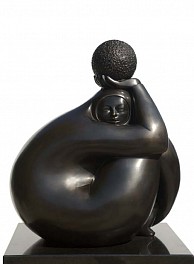BIOGRAPHY

B. 1954 -
I am a utopian. I must find the sense of circularity always present in men - and the sphere is the perfect expression of world globalism, which we are experiencing now. - Jorge Jiménez Deredia
Spheres seem to dominate Deredia’s life. When he was a young boy, Deredia saw them in the Museum of San Jose, Costa Rica, his home country. They were multi-sized ancient abstract sculptures, created by the Native Americans about 1,700 years ago. He was greatly impressed by these sculptures; to him they represented important proof of a civilization. These childhood spheres erected a bridge linking spirituality and rationality and they represented the glue for an ethnic group. "That time, inside the museum of San Jose, I realized that the only thing I could do in life was to sculpt, comparing myself day after day to those masterpieces of simplicity and greatness," says Deredia. Even though his parents wanted him to become a doctor, he knew that sculpting was the only possible path for him.
Initially Deredia started training by carving portraits in stone and wood. However, his attention was soon caught by organic shapes and their reactions with the environment, as well as the force of gravity and growth. After receiving his diploma, he started attending the Fine Arts Academy and the University of Coast Rica in San Jose. In 1976, Deredia won a competition for a 7 months scholarship to learn techniques of carving marble in Carrara, Italy. He was 22. For the first time, he had the chance to observe at close range the creations of Italian artists. He often went to Florence and Rome where he spent a lot of time drawing and studying the works of Bernini, Michelangelo and Brunelleschi in particular. After seven months, at the end of the scholarship, he ripped up his return flight ticket. He felt he had to stay in Italy and live near the Carrara marble quarries, where he has been living since. There he attended the Fine Arts Academy and later the Faculty of Architecture at the University of Florence.
The years spent in Florence provided Deredia with intellectual stimulus, which deeply changed his approach to artistic work, causing him to develop a new perception of life. "I do not like edges" explains Deredia, "because folds make life complicated." At this time, his work began to take a more spherical form, characterized by interlocking elements of negative and positive space. After 1978, following the birth of his son Esteban, the theme of maternity intensified in his works. This traditional theme of mother and child would later come up many times in his art.
In 1988, Deredia took part in his first Art Exhibition Venice Biennale. After that he was invited again in 1993 and 1999. He was the first non-European artist in five hundred years to have a sculpture placed in St. Peter's Basilica. The statue of San Marcellino, carved out of Carrara white marble, weighs 20 tons and is 5.35 meters high. It was unveiled in 2000 in the presence of Pope John Paul II. His monumental sculpture also dominates the Gardens of Latin America at Porte de Champerret in Paris (1989), and his works are displayed in 11 different countries in Europe, Asia, and the American continents. He has held 34 personal exhibitions and over 100 collective ones.
